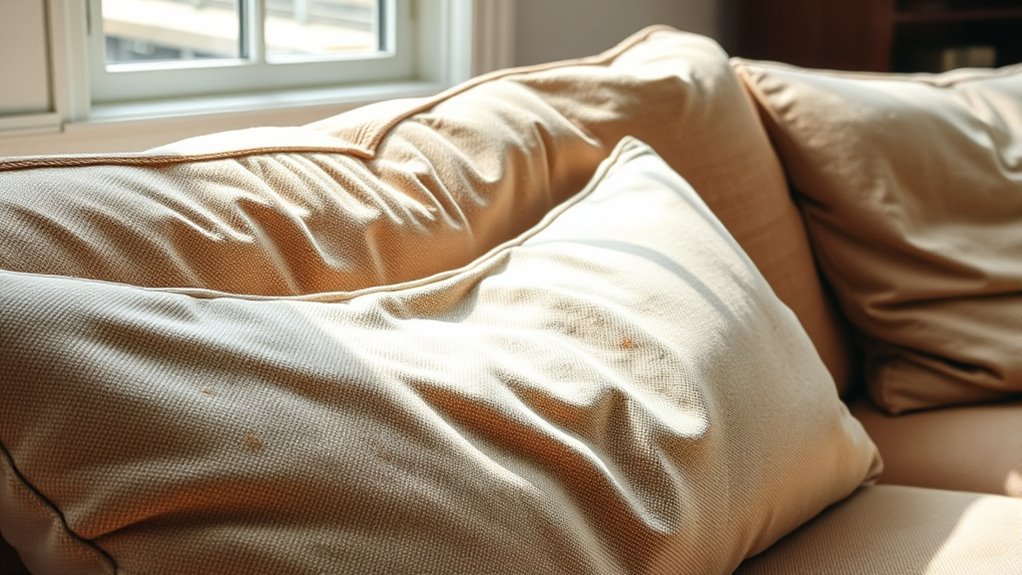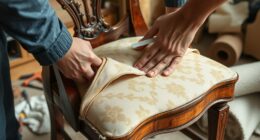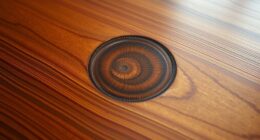To fix sagging couch cushions, start by removing the cushions and inspecting the foam or padding inside. Replace or add dense foam and batting to restore loft and support, and distribute it evenly to avoid lumps. Tighten the fabric covering the cushions using a staple gun or reupholster if needed. Reinforcing internal supports like webbing or springs can also help. For more detailed steps, you’ll discover how to achieve long-lasting results.
Key Takeaways
- Remove cushions and check for flattened or lumpy padding; replace or add foam or batting as needed.
- Reinforce or replace internal supports like webbing or springs to improve cushion structure.
- Reupholster or tighten fabric covers to restore proper tension and prevent further sagging.
- Use dense foam cut to size beneath existing padding for better support and resilience.
- Reassemble, fluff cushions, and regularly maintain to prolong cushion lifespan and maintain support.

Sagging couch cushions can make your furniture look worn out and uncomfortable, but luckily, fixing them is straightforward. The key lies in addressing the cushion padding and managing upholstery tension to restore their shape and support. Over time, cushions lose their firmness as the foam or filling compresses, and the upholstery fabric stretches or loosens, causing that dreaded sag. To tackle this, you need to reinforce the cushion padding and tighten the upholstery tension, which will give your sofa a fresh, supportive feel.
Start by removing the cushions from your sofa. Once you have them out, inspect the cushion padding. If it’s flattened or lumpy, you might need to replace or augment it. Foam inserts tend to compress over years, but you can easily upgrade by inserting new foam cut to size or adding a layer of batting or foam sheets underneath the existing padding. These additions will boost the cushion’s loft and resilience, making it feel plush again. Make sure the new padding is dense enough to hold its shape, but soft enough for comfort. When replacing or adding padding, distribute it evenly within the cushion cover to avoid lumps or uneven sagging.
Remove cushions, add dense foam or batting evenly for a plush, supportive seat.
Next, examine the upholstery tension. Over time, the fabric covering the cushions can become loose, contributing to sagging. To fix this, turn the cushions inside out if possible, and reattach or tighten the fabric. Many cushions are sewn with a zipper or have an open seam for easy access. Once open, pull the fabric taut and secure it with a staple gun or upholstery tacks if needed. If the fabric has stretched considerably, consider replacing the cover altogether or reupholstering the cushions for a tighter fit. Reapplying the fabric with increased tension ensures the cushion maintains its shape and provides better support.
In some cases, you might find the cushion’s frame or internal structure is damaged. If that’s the case, replacing the foam alone won’t suffice. You may need to reinforce the frame or add internal supports like webbing or springs. However, most sagging issues can be fixed by simply replacing or enhancing the cushion padding and tightening the upholstery tension. To maintain long-term support, consider adding additional internal support structures that can help prevent future sagging. With these simple steps, you’ll restore your couch’s comfort and appearance without investing in new furniture.
Finally, once you’ve adjusted the padding and upholstery tension, reassemble everything carefully. Fluff the cushions to evenly distribute the filling, and place them back on your sofa. You’ll notice an immediate improvement in support and appearance, making your furniture look fresh and inviting once again. With a little effort, you can extend the life of your couch and enjoy a more comfortable seat.
Frequently Asked Questions
How Long Does a DIY Cushion Fix Typically Last?
A DIY cushion fix usually lasts around 1 to 3 years, depending on usage and materials. When you replace the cushion foam and do upholstery sewing properly, you extend its lifespan. Keep in mind, high-quality foam and careful sewing can make your repair more durable. Regular fluffing and rotating cushions also help maintain their shape longer, ensuring your couch stays comfortable and looks good for years to come.
Are There Eco-Friendly Materials for Cushion Repair?
Think of eco-friendly materials as a breath of fresh air for your cushions. You can choose eco-friendly foam, which is made from sustainable resources, and biodegradable fabrics that break down naturally over time. These materials are gentle on the environment while providing comfort and durability. By opting for eco-friendly options, you’re giving your furniture a second life and helping protect the planet at the same time.
Can Professional Services Improve Cushion Longevity?
Yes, professional services can improve your cushion longevity through expert techniques and proper cushion maintenance. Professionals use specialized tools and methods to reinforce the cushions, guaranteeing they keep their shape and comfort longer. Regular maintenance, like flipping and rotating cushions, combined with professional repairs, helps prevent sagging and extends the lifespan of your couch. Trusting experts ensures your cushions stay supportive and look great for years to come.
What Tools Are Essential for Cushion Repair?
Imagine your favorite sofa sagging after years of use. To fix it, you’ll need essential tools like a staple remover, upholstery glue, and a utility knife. For cushion repair, you’ll often replace or reshape the cushion foam and secure it with upholstery glue. These tools make restoring your cushions easier, helping you revive your sofa’s comfort and appearance without professional help.
How to Prevent Future Sagging of Couch Cushions?
You can prevent future sagging by choosing the right cushion stuffing options like foam, down, or polyester fiberfill, which offer better support and durability. Regularly flipping and rotating your cushions also helps maintain their shape. Consider cushion cover replacement if covers are worn out or loose, as this can improve support and appearance. Taking these steps guarantees your couch stays comfortable and looking great longer.
Conclusion
Now, as you sit comfortably again, it’s funny how a simple fix can make your whole living room feel new. You might not have planned to tackle those cushions today, but sometimes, small moments like this remind you that fixing what’s broken can bring unexpected comfort. It’s amazing how a little effort turns a sagging seat into your favorite spot again. Sometimes, it’s the little things that make all the difference.








